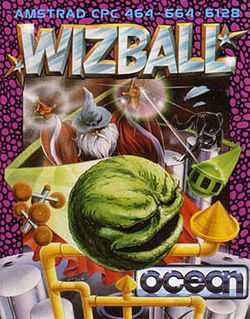Wizball
| Wizball | |
|---|---|
 | |
| Developer(s) | Sensible Software |
| Publisher(s) | Ocean Software |
| Composer(s) | Martin Galway |
| Platform(s) | Amstrad CPC, Commodore 64, ZX Spectrum, Amiga, Atari ST, DOS |
| Release date(s) | 1987 |
| Genre(s) | Shoot 'em up |
| Mode(s) | Single-player |
| Distribution | Floppy disk, Cassette |
Wizball is a computer game written by Jon Hare and Chris Yates (who together formed the company Sensible Software) and released in 1987 for the Commodore 64, ZX Spectrum and Amstrad CPC. Versions for the Amiga, Atari ST and PC were also released. The music in the Commodore 64 version was composed by Martin Galway.
Wizball's more comical sequel, Wizkid, was released in 1992 for the Amiga, Atari ST and IBM PC.
Gameplay
Wizball is a scrolling shooter in similar vein to Gradius with an additional collection dynamic. It is a horizontally scrolling game taking place over eight levels, which involves navigating around a landscape and shooting at sprites. However, the aim of the game is to collect droplets of coloured paint to colour the level. Each level starts off as monochromatic, drawn in three shades of grey, and needs three colours (red, blue, and green) to be collected to complete it. The player, a wizard who has taken the form of a green ball, can navigate between the levels through portals. At first the wizard only has access to the first three levels, but completing levels gains access to further levels. Each level has bouncing spheres of a different colours, and shooting them releases droplets, which may be collected. At the same time, each level needs a different colour to be added, which can be composed by collecting sufficient quantities of the correct colours. On later levels, the spheres of paint start shooting bullets, further adding to the challenge.
The wizard himself is not capable of collecting paint droplets, and is initially capable of very limited movement, bouncing up and down at a fixed rate, with the player only controlling a speed of rotation, and thus how fast it will move horizontally after next touching the ground. Collecting green pearls (which appear when some sprites have been shot) gives the player tokens which can be used to "buy" enhancements, such as greater control over movement and improved firepower, and also a companion known as Catellite. Catellite (ostensibly the wizard's cat) is also spherical in form. It normally follows the wizard, but it can also be moved independently by holding down the fire button whilst moving the joystick (which also renders the wizard uncontrollable). Only Catellite is capable of collecting paint droplets; the player has to use it to do so. In the two-player mode, Catellite is controlled by the second player. As well as droplets of colours, sometimes droplets of other colours also appear, having various effects. These include:
- Light blue - causes a "filth raid", where a wave of fast-moving enemies appear, shooting bullets at the player.
- Grey - changes Catellite into an "Indestructacat", making it invulnerable to enemies.
- White - gives an extra life.
- Purple - changes Catellite into a "mutant cat", causing it to disobey the player's controls.
- Black - causes "freaky bits", turning most of the scenery black.
Versions
The Commodore 64 version is the original. The Atari ST and Amiga versions were ported by other programming teams. On the Commodore 64 version, enemy waves spawn in groups, with 4 or 5 on the landscape at a time, at least one of which is always color spheres; this made the game extremely difficult, but allowed the player to preferentially hunt the spheres if they needed only a small amount of color to complete their current combination. The Amiga and Atari ST versions spawn only one wave at a time, which makes the game easier, but requires the player to "grind" until a wave of spheres is chosen to spawn.
More recently in 2007, the game's 20th anniversary year, a remake for Windows and Mac OS operating systems has been produced by Graham Goring. The gameplay of the remake is based on the Commodore 64 version but contains updated graphics, music and sound effects.
Sequel
In 1992, Sensible Software developed a sequel Wizkid which was released by Ocean Software. Although the story in Wizkid continues directly from Wizball, the actual games are only superficially related to each other.
Reception
| Reception | ||||||||||||||||||||||||||||||||||||||||||||||||||||||||||||||||||||
|---|---|---|---|---|---|---|---|---|---|---|---|---|---|---|---|---|---|---|---|---|---|---|---|---|---|---|---|---|---|---|---|---|---|---|---|---|---|---|---|---|---|---|---|---|---|---|---|---|---|---|---|---|---|---|---|---|---|---|---|---|---|---|---|---|---|---|---|---|
| ||||||||||||||||||||||||||||||||||||||||||||||||||||||||||||||||||||
| ||||||||||||||||||||||||||||||||||||||||||||||||||||||||||||||||||||
The game won a Sizzler award in the July 1987 issue of ZZAP!64 magazine, and later went on to be crowned its Game of the Decade.
References
- ↑ http://www.worldofspectrum.org/showmag.cgi?mag=C+VG/Issue069/Pages/CVG06900023.jpg
- ↑ http://www.worldofspectrum.org/showmag.cgi?mag=Crash/Issue45/Pages/Crash4500023.jpg
- ↑ http://www.worldofspectrum.org/showmag.cgi?mag=SinclairUser/Issue067/Pages/SinclairUser06700052.jpg
- ↑ http://www.ysrnry.co.uk/articles/wizball.htm
- ↑ http://www.zzap64.co.uk/zzap100/100thspec5.html
External links
- Wizball at MobyGames
- Wizball at Lemon 64
- Wizball at World of Spectrum
- Wizball at CPC Zone
- Wizball at Atari Legends
- Wizball Remake by Graham Goring
- Wizball at c64-wiki.com
- Wizball complete play-through at recordedamigagames.ath.cx